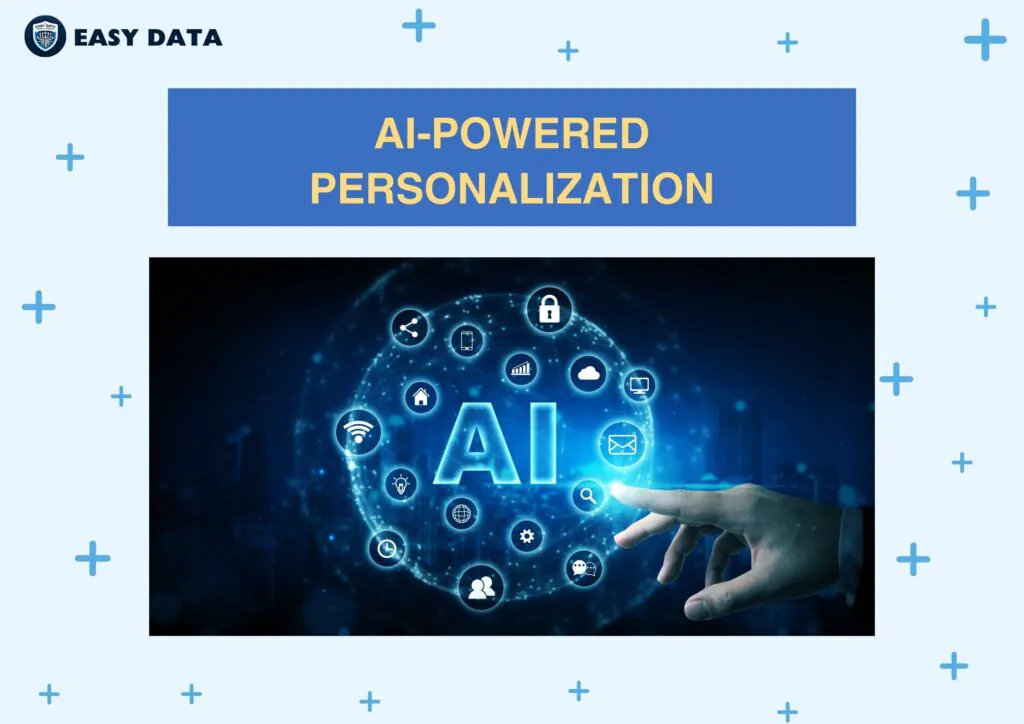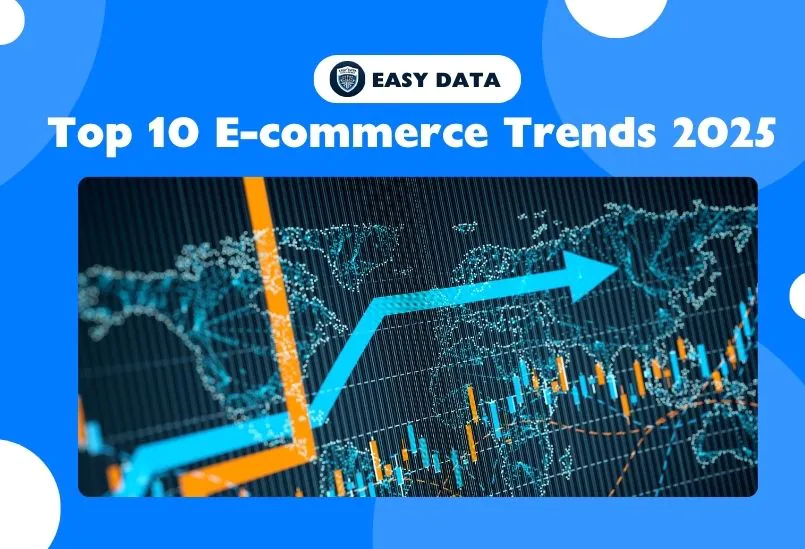E-commerce continues to grow at an unprecedented pace, reshaping the way businesses operate and consumers shop. By 2025, the global e-commerce market is projected to exceed $8 trillion, driven by technological advancements, changing consumer demands, and innovations across industries. Staying competitive in this evolving landscape requires a deep understanding of the trends shaping the future of online retail.
This article explores 10 key e-commerce trends for 2025, detailing how businesses can leverage these changes to thrive in a competitive market.
- 1. AI-Powered Personalization: Redefining Customer Experience
- 2. The Rise of Voice Commerce
- 3. Sustainability: The New Business Imperative
- 4. Mobile Commerce Dominance
- 5. Social Commerce: Shopping Meets Social Media
- 6. Subscription-Based Models
- 7. AR and VR: Immersive Shopping Experiences
- 8. Cross-Border E-commerce Boom
- 9. Blockchain: The Future of Secure Transactions
- 10. Same-Day Delivery and Smart Logistics
- Conclusion
1. AI-Powered Personalization: Redefining Customer Experience

Personalization has been a cornerstone of e-commerce success, and artificial intelligence (AI) is taking it to the next level. AI-powered personalization enables businesses to deliver unique experiences tailored to individual customers, boosting engagement and loyalty.
How AI Is Transforming E-commerce
- Behavioral Analytics: AI analyzes browsing history, purchase behavior, and demographic data to recommend products that customers are most likely to buy.
- Dynamic Pricing: AI systems can adjust prices in real-time based on demand, competition, and customer profiles.
- Predictive Analytics: Businesses can anticipate future trends and inventory needs using AI, ensuring they stock the right products.
Example
Amazon’s recommendation engine generates 35% of its total revenue by suggesting products customers are likely to purchase.
Pro Tip: Implement AI-driven tools like chatbot assistants, predictive analytics, and personalization engines to elevate the customer experience.
2. The Rise of Voice Commerce
With the widespread adoption of smart speakers and voice-enabled devices like Alexa, Google Assistant, and Siri, voice commerce is becoming a significant driver of e-commerce sales.
What Makes Voice Commerce Popular?
- Convenience: Voice shopping allows users to search for products and make purchases hands-free.
- Speed: Voice commands significantly reduce the time required to find and buy products.
- Integration with IoT: Smart appliances can automatically reorder items like groceries or cleaning supplies.
Future Outlook
By 2025, voice commerce sales are expected to reach $40 billion in the U.S. alone. Optimizing for voice search will be a critical strategy for e-commerce businesses.
Pro Tip: Focus on long-tail, conversational keywords and ensure your product descriptions are optimized for voice search.
3. Sustainability: The New Business Imperative
Sustainability is no longer just a buzzword—it’s a core expectation for consumers. Businesses prioritizing eco-friendly practices are not only attracting environmentally conscious customers but also gaining a competitive edge.
Sustainable E-commerce Practices
- Eco-Friendly Packaging: Using biodegradable or compostable materials for packaging.
- Carbon Offsetting: Companies like Shopify and Etsy are investing in renewable energy projects to reduce their carbon footprint.
- Circular Economy: Brands are offering recycling programs or refurbishing services to minimize waste.
Why It Matters
A 2023 study revealed that 81% of consumers prefer to buy from sustainable brands.
Pro Tip: Highlight your sustainability efforts in your marketing campaigns to connect with eco-conscious customers.
4. Mobile Commerce Dominance
Mobile commerce (m-commerce) has become the dominant force in e-commerce. By 2025, more than 75% of e-commerce sales will come from mobile devices.
Key Innovations Driving M-Commerce
- Progressive Web Apps (PWAs): PWAs combine the functionality of mobile apps with the accessibility of websites, offering seamless experiences.
- Mobile Wallets: Digital payment solutions like Apple Pay and Google Pay are simplifying transactions.
- One-Tap Checkouts: Reducing friction in the payment process to lower cart abandonment rates.
Example
Zalando, a European fashion retailer, implemented PWAs, resulting in a 35% increase in mobile conversions.
Pro Tip: Optimize your website for mobile responsiveness and invest in fast-loading, intuitive interfaces.
5. Social Commerce: Shopping Meets Social Media

Social commerce combines the power of social media engagement with the convenience of e-commerce, enabling users to shop directly on platforms like Instagram, TikTok, and Pinterest.
How Social Commerce Is Changing the Game
- In-App Purchases: Customers can browse and buy without leaving the app.
- Live Shopping Events: Brands and influencers host live streams to showcase products and answer questions in real-time.
- User-Generated Content (UGC): Social proof through customer reviews, unboxings, and testimonials drives conversions.
Why It Works
Social commerce taps into impulse buying and leverages the influence of community and trust.
Pro Tip: Invest in shoppable posts and collaborate with influencers to amplify your brand’s reach.
6. Subscription-Based Models
Subscription models are transforming the way consumers shop, offering convenience, cost savings, and exclusivity.
Popular Subscription Types
- Product Subscriptions: Monthly deliveries of consumables like beauty products or groceries.
- Membership Plans: Amazon Prime and Costco offer perks like free shipping or member-only discounts.
- Digital Subscriptions: Access to premium content or services, such as Adobe Creative Cloud or Netflix.
The Benefits for Businesses
Subscriptions provide predictable revenue streams and foster long-term customer relationships.
Pro Tip: Experiment with tiered subscription plans to attract a wider audience.
7. AR and VR: Immersive Shopping Experiences
Augmented Reality (AR) and Virtual Reality (VR) are revolutionizing online shopping by creating interactive and immersive experiences.
Applications of AR and VR
- Virtual Try-Ons: AR allows customers to visualize products like clothing, makeup, or furniture before purchasing.
- VR Stores: Virtual showrooms let shoppers explore products in a 3D environment.
- Interactive Tutorials: VR can be used to demonstrate complex products or services.
Example
IKEA’s AR app, “IKEA Place,” enables users to see how furniture fits into their homes, reducing purchase hesitation.
Pro Tip: Integrate AR/VR features to enhance customer confidence and reduce return rates.
8. Cross-Border E-commerce Boom

Globalization and advancements in logistics are driving the growth of cross-border e-commerce. By 2025, the market is expected to exceed $1 trillion.
What’s Fueling This Trend?
- Localized Websites: Offering region-specific content, languages, and currencies.
- Efficient Shipping: Faster delivery through global logistics partners.
- Simplified Customs Processes: Technology streamlines tax and duty calculations.
Challenges and Opportunities
While international expansion comes with challenges like regulatory compliance and cultural differences, the rewards—access to new markets and increased sales—are substantial.
Pro Tip: Partner with global payment gateways and logistics providers to simplify cross-border operations.
9. Blockchain: The Future of Secure Transactions
Blockchain technology is revolutionizing e-commerce by enhancing transparency, security, and efficiency in transactions.
Key Applications in E-commerce
- Cryptocurrency Payments: Accepting Bitcoin, Ethereum, and other digital currencies opens new payment channels.
- Transparent Supply Chains: Customers can verify the authenticity and origin of products.
- Smart Contracts: Automating agreements for faster, error-free transactions.
Why It Matters
Blockchain builds trust among consumers by ensuring secure and transparent operations.
Pro Tip: Explore blockchain solutions to improve operational efficiency and customer trust.
10. Same-Day Delivery and Smart Logistics
Fast and reliable delivery has become a baseline expectation for customers. Innovations in logistics are making same-day and even next-hour deliveries a reality.
Innovations in Last-Mile Delivery
- Micro-Fulfillment Centers: Small warehouses in urban areas reduce delivery times.
- Drones and Autonomous Vehicles: Cutting-edge technology for fast and eco-friendly deliveries.
- AI-Driven Logistics: Optimizing delivery routes to ensure speed and efficiency.
Example
Amazon’s Prime Air program uses drones to deliver packages in under 30 minutes.
Pro Tip: Collaborate with tech-driven logistics providers to enhance your delivery capabilities.
Conclusion
The e-commerce trends of 2025 highlight a future where technology, sustainability, and customer-centric strategies are at the forefront. From AI-driven personalization and immersive AR/VR experiences to sustainable practices and global expansion, businesses must adapt to these changes to remain competitive.
By implementing these trends into your strategy, you can build a future-proof business that meets the demands of the modern consumer while staying ahead of industry competitors.
For businesses seeking tailored, high-quality datasets, Easy Data offers unparalleled value. Ready to optimize your web scraping process? Book a demo with Easy Data today and take your data strategy to the next level!


Leave a Reply